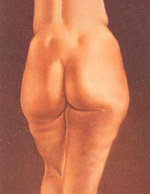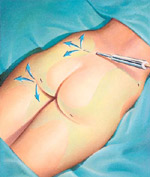
Before Liposuction
Suction-assisted lipectomy – also known as liposuction, fat suction, or suction lipectomy – is a technique to remove unwanted fat deposits from specific areas of the body, including the chin, neck, and cheeks; the upper arms and above the breasts; the abdomen, buttocks, hips, and thighs; and the knees, calves, and ankles. Liposuction is one of the commonest procedures performed at plastic surgicentre in Doha, Qatar. Liposuction is not a substitute for weight reduction, but a method of removing localized fat that doesn’t respond to dieting and exercise. If you’re considering liposuction, this will give you a basic understanding of the procedure – when it can help, how it’s performed, and what results you can expect. It can’t answer all of your questions, since a lot depends on the individual patient and the surgeon. Please ask your doctor about anything you don’t understand.
Women may have liposuction performed under the chin, on their hips, thighs, and stomach, and in the underarm and breast area.
The best candidates for liposuction
Liposuction can enhance your appearance and your self-confidence, but it won’t necessarily change your looks to match your ideal, or cause other people to treat you differently. Before you decide to have surgery, think carefully about your expectations and discuss them with your surgeon.
The best candidates for liposuction are of relatively normal weight but have pockets of excess fat in particular areas. You should be physically healthy, psychologically stable, and realistic in your expectations. Most important, having firm, elastic skin will result in a better final contour. (Hanging skin won’t reshape to your body’s new contours, and may require an additional procedure to surgically remove the excess skin. This procedure will leave visible scars.)

Male Before Liposuction
For men, common sites include under the chin and around the waist. Liposuction may also be used in the reduction of enlarged male breasts, a condition known as gynecomastia.
Suction lipectomy is not recommended if you’ve had recent surgery on the spot to be sculpted, if you have poor blood circulation in that area, or if you have heart or lung disease. You should also understand that liposuction by itself will not improve the dimpled skin known as cellulite. At Plastic Surgicenter we offer some other techniques that improve this condition.
For men, common sites include under the chin and around the waist. Liposuction may also be used in the reduction of enlarged male breasts, a condition known as gynecomastia.
All surgery carries some uncertainty and risk
Suction-assisted lipectomy is normally safe, as long as patients are carefully selected, the operating facility is properly equipped, and the physician is adequately trained in body contouring as well as general surgery.
Nevertheless, in rare instances, the procedure may cause trauma, particularly when multiple or very extensive areas are suctioned at one time. Other infrequent, but possible, complication include fluid accumulation (which must be drained). You can reduce your risks by choosing a qualified plastic surgeon who has been granted privileges to perform liposuction at an accredited hospital, and by closely following his advice.
The scars from liposuction are small and strategically placed to be hidden from view, even in a bikini. However, other cosmetic problems may occur, even if your surgeon is very skilled. They may include rippling of the skin over the treated area, and pigmentation changes (such as brown spots) that may become permanent if exposed to the sun. Asymmetry (uneven contour or shape) sometimes requires a second procedure.
Planning your surgery
In your initial consultation, the surgeon will evaluate your health, determine where your fat deposits lie, and carefully assess your skin tone. Your doctor should explain any alternative body-contouring methods that may be appropriate – such as abdominoplasty, or tummy tuck – and discuss the options or the combination of procedures that would be best for you.
Be frank in discussing your expectations with your surgeon. He or she should be equally frank with you, describing the procedure in detail and explaining its risks and limitations. Your surgeon should also explain the anesthesia he or she will use, the type of facility where the surgery will be performed, and the costs involved.
During this consultation, be sure to tell your surgeon about any large weight losses or gains you’ve had at any time. You should also inform your surgeon if you smoke, and if you’re taking any medications, vitamins, or other drugs.
Don’t hesitate to ask your doctor any questions you may have, especially those regarding your expectations and concerns about the results.
Preparing for your surgery
The best candidates for liposuction are normal weight with localized areas of excess fat– for example, in the buttocks, hips, and thighs.
If you’re having extensive liposuction, discuss the possibility of having blood drawn ahead of time with your doctor. Your own blood can be used to help replace the blood and other fluids you’ll lose during surgery if your doctor feels this is necessary.
Your surgeon will give you specific instructions on how to prepare for surgery, including guidelines on eating and drinking, smoking, and taking or avoiding vitamins, iron tablets, and certain medications. If you develop a cold or an infection of any kind, especially a skin infection, your procedure will have to be postponed.
While you’re making preparations, be sure to arrange for someone to drive you home after your surgery and, if needed, to help you out for a day or two.
Where your surgery will be performed
Suction-assisted lipectomy may be performed in a surgeon’s office-based facility, an outpatient surgery center, or a hospital. It’s usually done on an outpatient basis, for cost containment and convenience. Extensive procedures may require a hospital stay of two or three days.

Best Candidates For Liposuction
The best candidates for liposuction are normal weight with localized areas of excess fat– for example, in the buttocks, hips, and thighs.
Types of anesthesia
If your procedure is not too extensive – that is, the amount of fat and fluid removed does not exceed an amount your doctor will define based on your health, body size, and surgical procedure – liposuction can be performed under local anesthesia, which numbs the area, combined with a sedative to make you drowsy. You’ll be awake but relaxed, and will feel minimal discomfort. Some surgeons may instead use an epidural block, similar to the anesthesia used in childbirth.
If your doctor plans to suction a large area, or to treat several sites, you’ll probably have general anesthesia. In that case, you’ll sleep through the operation.
The surgery

The Surgery
The surgeon inserts a cannula through small incisions in the skin. At the other end of the tube is a vacuum-pressure unit that suctions off the fat
The surgeon inserts a cannula through small incisions in the skin. At the other end of the tube is a vacuum-pressure unit that suctions off the fat.
Suction-assisted lipectomy usually takes an hour or two, but the time required may vary considerably – from thirty minutes to several hours, depending on the area and amount being suctioned.
To begin the procedure, the surgeon makes a small incision, just large enough to allow the insertion of a hollow tube called a cannula. The opposite end of the cannula is attached to a machine that creates a strong vacuum. The surgeon manipulates the cannula deep within the fat layers under the skin, breaking up the fat and suctioning it out. Sometimes additional incisions are needed to remove all areas of fat.
If you’ve had local anesthesia, you’ll feel some vibration and friction during the procedure. You may also feel a stinging sensation as the cannula moves closer to the muscle.
You’ll lose fluid along with the fat during liposuction, and it’s crucial that this fluid be replaced to keep your body from going into shock.
After your surgery
After surgery, a drainage tube may be inserted beneath your skin for one day to remove any fluid build up that occurs. A snug elastic dressing, girdle, or body stocking must be worn over the treated area to control swelling and bleeding, and to help your skin shrink to fit your new contour. You may need to wear this garment continuously for two to three weeks, then just in the day time for a few weeks more, depending on your surgeon’s instructions. Your doctor may also prescribe antibiotics to prevent infection.

After Surgery
A snug compression garment worn after surgery helps reduce swelling.
Don’t expect to look or feel great right after surgery. You’ll even be heavier for a while, because of the extra fluids you’ve been given. The suctioned areas will be swollen and bruised, and you may feel a burning sensation. The pain can be controlled with medications prescribed by your surgeon, though you may still feel stiff and sore for a few days. You may temporarily lose all feeling in the suctioned area; don’t worry – it will return.
It’s not unusual to feel depressed in the days or weeks following surgery. Try to keep in mind that this is normal and will subside as you begin to look and feel better.
Getting back to normal
Healing is a gradual process. Your surgeon will probably tell you to start walking around as soon as possible (to help prevent blood clots from forming in your legs), but to avoid more strenuous activity for two to four weeks. Any stitches will be removed in five to ten days or dissolve, and you should be back at work in 2 – 3 days, or as much as two weeks after your surgery. When you resume activity depends on the extent of your procedure, how you feel and what your doctor recommends.
While most of the swelling and discoloration will be gone a month or two after surgery, some swelling can re main for six months or more. Your surgeon will schedule follow-up visits to monitor your progress and to see if any additional procedures are needed.
If you have any unusual symptoms between visits – for example, heavy bleeding or a sudden increase in pain – or any questions about what you can and can’t do, don’t hesitate to call your doctor.
Your new look

New Look
As healing progresses, a more proportional look will emerge.
Suction-assisted lipectomy is a highly effective technique for giving you a new body contour with very little scarring. The results can be permanent, providing you eat sensibly and exercise regularly. If you do gain weight, you’ll probably gain it more uniformly throughout your body, not just in the former “bulges.”
A slimmer body contour can help you feel more confident and comfortable.
Most patients are very satisfied with the results of their liposuction – they feel more comfortable in a wide variety of clothes, and more at ease with their bodies. As long as your expectations are realistic, you should be happy with your new shape.

Noticeable Difference
You will see a noticeable difference in the shape of your body quite soon after surgery. However, improvement will become even more apparent after about six weeks, when most of the swelling has subsided.
If your expectations are realistic, you will probably be very pleased with the results of your surgery. You may find that you are more comfortable in a wide variety of clothes and more at ease with your body. And, by eating a healthy diet and getting regular exercise, you can help to maintain your new shape permanently.
The information on this web site is only intended as an introduction to this procedure and should not be used to determine whether you will have the procedure performed nor as a guarantee of the result.
The best method of determining your personal options is to schedule a personal consultation with Dr. Makki. He will be able to answer specific questions related to your situation.
Please don’t hesitate to call for any questions that you might have

 Twitter
Twitter Facebook
Facebook Instagram
Instagram Google +
Google +